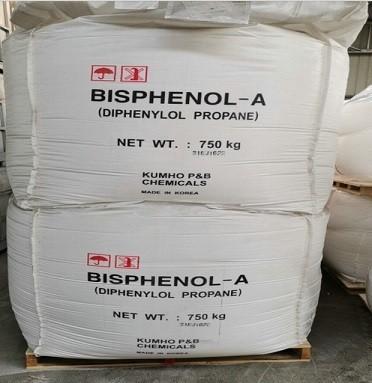 |
 |
2,2-Bis (4-hydroxyphenol) propane 2,2-Bis(4,4'-hydroxyphenyl)propane 2,2-Bis(4-hydroxyphenyl)-propa 2,2-Bis(4-hydroxyphenyl)propane 2,2-Bis(hydroxyphenyl)propane 4,4'-(1-Methylethane-1,1-diyl)diphenol 4,4'-(1-Methylethylidene)bisphenol 4,4'-(2,2-Propanediyl)diphenol 4,4’-(1-methylethylidene)bis-pheno 4,4’-(1-methylethylidene)bisphenol 4,4’-(1-methylethylidene)bis-Phenol 4,4″-isopropylidenediphenol 4,4'-Methylethylidendbisphenol 4,4'-propane-2,2-diyldiphenol b,b'-Bis(p-hydroxyphenyl)propane Bicifadino Bicifadinum Bis(p-hydroxyphenyl)propane BPA dimethyl bis(p-hydroxyphenyl)methane EINECS 201-245-8 Hidorin F 285 MFCD03427359 Parabis Phenol, 4,4'-(1-methylethylidene)bis-



Safety Information about?Bisphenol A (CAS NO.80-05-7):
Hazard Codes: Xn
Xn
Risk Statements: 37-41-43-62
37:?Irritating to the respiratory system?
41:?Risk of serious damage to eyes?
43:?May cause sensitization by skin contact?
62:?Possible risk of impaired fertility?
Safety Statements:?26-36/37/39-45-46
26:?In case of contact with eyes, rinse immediately with plenty of water and seek medical advice?
36/37/39:?Wear suitable protective clothing, gloves and eye/face protection?
45: In case of accident or if you feel unwell, seek medical advice immediately (show label where possible)?
46:?If swallowed, seek medical advice immediately and show this container or label?
RTECS:? SL6300000
HS Code:? 29072300
Poison by intraperitoneal route. Moderately toxic by ingestion, inhalation, and skin contact. Experimental teratogenic and reproductive effects. A skin and eye irritant. When heated to decomposition it emits acrid and irritating fumes.
General Information of?Bisphenol A (CAS NO.80-05-7): As in any fire, wear a self-contained breathing apparatus in pressure-demand, MSHA/NIOSH (approved or equivalent), and full protective gear.
Extinguishing Media: Use water spray, dry chemical, carbon dioxide, or chemical foam.?
Handling: Avoid breathing dust, vapor, mist, or gas. Avoid contact with skin and eyes. Avoid ingestion and inhalation. Use only in a chemical fume hood.
Storage: Store in a cool, dry place. Store in a tightly closed container.
| Organism | Test Type | Route | Reported Dose (Normalized Dose) | Effect | Source |
|---|---|---|---|---|---|
| guinea pig | LD50 | oral | 4gm/kg (4000mg/kg) | AUTONOMIC NERVOUS SYSTEM: OTHER (DIRECT) PARASYMPATHOMIMETIC BEHAVIORAL: CONVULSIONS OR EFFECT ON SEIZURE THRESHOLD BEHAVIORAL: ATAXIA |
Gigiena i Sanitariya. For English translation, see HYSAAV. Vol. 33(7), Pg. 25, 1968. |
| mammal (species unspecified) | LD50 | oral | 6500mg/kg (6500mg/kg) | ? | "Toxicology of Drugs and Chemicals," Deichmann, W.B., New York, Academic Press, Inc., 1969Vol. -, Pg. 135, 1969. |
| mouse | LC | inhalation | > 1700mg/m3/2H (1700mg/m3) | BEHAVIORAL: SOMNOLENCE (GENERAL DEPRESSED ACTIVITY) BEHAVIORAL: ATAXIA LUNGS, THORAX, OR RESPIRATION: DYSPNEA |
Toksikologiya Novykh Promyshlennykh Khimicheskikh Veshchestv. Toxicology of New Industrial Chemical Substances. For English translation, see TNICS*. Vol. 2, Pg. 50, 1961. |
| mouse | LD50 | intraperitoneal | 150mg/kg (150mg/kg) | ? | National Technical Information Service. Vol. AD691-490, |
| mouse | LD50 | oral | 2400mg/kg (2400mg/kg) | AUTONOMIC NERVOUS SYSTEM: OTHER (DIRECT) PARASYMPATHOMIMETIC BEHAVIORAL: CONVULSIONS OR EFFECT ON SEIZURE THRESHOLD BEHAVIORAL: ATAXIA |
Gigiena i Sanitariya. For English translation, see HYSAAV. Vol. 33(7), Pg. 25, 1968. |
| mouse | LDLo | subcutaneous | 2500mg/kg (2500mg/kg) | BEHAVIORAL: SOMNOLENCE (GENERAL DEPRESSED ACTIVITY) LIVER: FATTY LIVER DEGERATION |
Toksikologiya Novykh Promyshlennykh Khimicheskikh Veshchestv. Toxicology of New Industrial Chemical Substances. For English translation, see TNICS*. Vol. 2, Pg. 50, 1961. |
| rabbit | LD50 | oral | 2230mg/kg (2230mg/kg) | ? | American Industrial Hygiene Association Journal. Vol. 28, Pg. 301, 1967. |
| rabbit | LD50 | skin | 3mL/kg (3mL/kg) | ? | AMA Archives of Industrial Hygiene and Occupational Medicine. Vol. 4, Pg. 119, 1951. |
| rat | LD50 | oral | 3250mg/kg (3250mg/kg) | ? | American Industrial Hygiene Association Journal. Vol. 28, Pg. 301, 1967. |
Serious eye damage, Category 1
Skin sensitization, Category 1
Specific target organ toxicity \u2013 single exposure, Category 3
Reproductive toxicity, Category 1B
| Pictogram(s) |    |
|---|---|
| Signal word | Danger |
| Hazard statement(s) | H318 Causes serious eye damage H317 May cause an allergic skin reaction H335 May cause respiratory irritation H360F |
| Precautionary statement(s) | |
| Prevention | P280 Wear protective gloves/protective clothing/eye protection/face protection. P261 Avoid breathing dust/fume/gas/mist/vapours/spray. P272 Contaminated work clothing should not be allowed out of the workplace. P271 Use only outdoors or in a well-ventilated area. P201 Obtain special instructions before use. P202 Do not handle until all safety precautions have been read and understood. |
| Response | P305+P351+P338 IF IN EYES: Rinse cautiously with water for several minutes. Remove contact lenses, if present and easy to do. Continue rinsing. P310 Immediately call a POISON CENTER/doctor/\u2026 P302+P352 IF ON SKIN: Wash with plenty of water/... P333+P313 If skin irritation or rash occurs: Get medical advice/attention. P321 Specific treatment (see ... on this label). P362+P364 Take off contaminated clothing and wash it before reuse. P304+P340 IF INHALED: Remove person to fresh air and keep comfortable for breathing. P312 Call a POISON CENTER/doctor/\u2026if you feel unwell. P308+P313 IF exposed or concerned: Get medical advice/ attention. |
| Storage | P403+P233 Store in a well-ventilated place. Keep container tightly closed. P405 Store locked up. |
| Disposal | P501 Dispose of contents/container to ... |
none
 |
 |
 |

